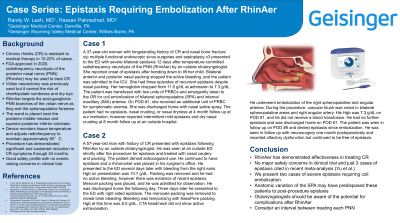Rhinology/Allergy
(074) Case Report: Epistaxis Requiring SPA and IMA Embolization After RhinAer
Monday, October 2, 2023
2:45 PM - 3:45 PM East Coast USA Time

Has Audio

Randy W. Lesh, MD
Resident Physician
Geisinger
Danville, Pennsylvania, United States- HP
Hassan Paknezhad, MD
Associate Otolaryngologist
Geisinger Wyoming Valley Medical Center
Wilkes-Barre, PA, USA
Presenting Author(s)
Senior Author(s)
Disclosure(s):
Randy W. Lesh, MD: No relevant relationships to disclose.
Introduction: We present a 37-year-old woman with bilateral epistaxis requiring IMA embolization after RhinAer for chronic rhinitis (CR). We outline her relevant history, clinical presentation, and treatment course.
Methods: The electronic health record was utilized to review clinical documentation, imaging, and lab results. Reported complications of RhinAer were reviewed.
Results: A 37-year-old woman with longstanding history of CR and nasal bone fracture s/p multiple functional endoscopic sinus surgeries and septoplasty x3 presented to the ED with severe bilateral epistaxis 12 days after temperature-controlled radiofrequency neurolysis of the posterior nasal nerve (PNN) (RhinAer) by an outside otolaryngologist. She reported onset after bending down to lift her child. Bilateral anterior and posterior nasal packing stopped the active bleeding, and the patient was admitted to the ICU. Five hours later, she had three episodes of epistaxis within two hours despite nasal packing. Her hemoglobin dropped from 11.6 g/dL at admission to 7.3 g/dL. The patient was transfused with two units of PRBCs and emergently taken to the OR for coil embolization of bilateral sphenopalatine (SPA) and internal maxillary (IMA) arteries. On POD #1, she received an additional unit of PRBC for symptomatic anemia then discharged home with nasal saline spray. The patient had no epistaxis, nasal crusting, or nasal dryness through 4-month follow-up.
Conclusions: RhinAer is a minimally invasive procedure which has demonstrated significant and sustained reduction in CR symptoms through 24 months post-procedure. The intervention has a good safety profile with no events raising concerns in clinical trial. We present a case of severe bilateral epistaxis 12 days post-procedure requiring nasal packing, blood product, and bilateral SPA and IMA coil embolization. Anatomic variation of the SPA might have predisposed the patient to post-procedure epistaxis. Otolaryngologists should be aware of the potential for complications after RhinAer and may consider a 3-week interval between treating each PNN.
